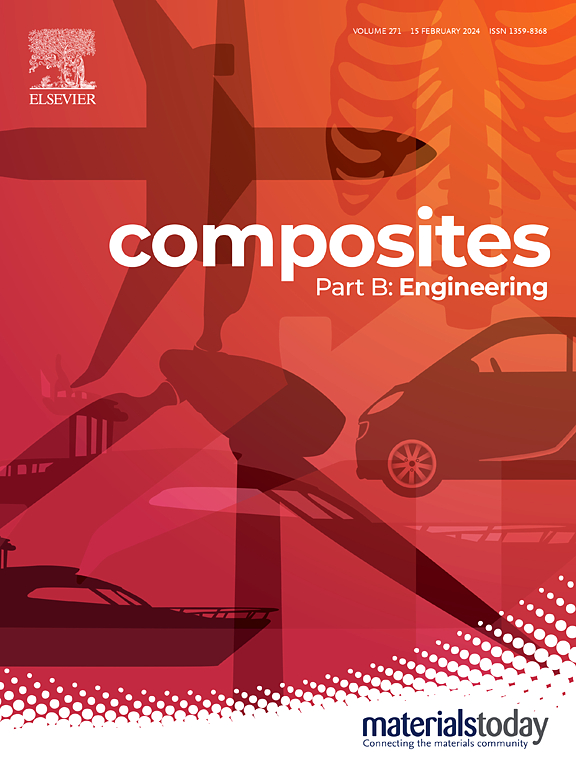Core-shell BN/SCF architecture with phonon-electronic dual conduction pathways for synergistic enhancement of thermal conductivity, EMI shielding and mechanical properties in CF/EP composites
IF 14.2
1区 材料科学
Q1 ENGINEERING, MULTIDISCIPLINARY
引用次数: 0
Abstract
The urgent demand for reliable thermal management, electromagnetic interference (EMI) shielding and mechanical properties in aerospace electronics operating under extreme conditions drives the development of advanced multifunctional composites. Herein, the core-shell boron nitride/short carbon fiber (BN/SCF), synthesized via diazonium coupling and electrostatic assembly, is strategically aligned onto CF felts using a high-voltage electric field. Subsequent lamination with CF cloth and vacuum-assisted resin infusion (VARI) molding to fabricate multifunctional carbon fiber/epoxy resin (CF/EP) composites. The three-dimensional CF felt establishes thermal conduction bridges within EP interlayers, effectively mitigating the intrinsic limitation of out-of-plane thermal conductive. Concurrently, the BN nanoplates coated onto SCF enhance EP phonon transport via architecturally ordered crystalline lattice alignment, while oriented SCFs extend phonon pathways, collectively establishing phonon-electron dual thermal channels. Consequently, the CF/EP composites achieved optimal out-of-plane and in-plane thermal conductivities of 1.20 and 14.08 W m−1 K−1. The unique core-shell BN/SCF promotes multiple reflections of electromagnetic waves (EMWs) through an energy band structure mismatch between the wide bandgap BN and conductive SCF, and BN dielectric polarization, achieving exceptional shielding effectiveness (SE) of 50.06 dB, which was a 63.33 % improvement over the original CF/EP composites (30.65 dB). Moreover, the core-shell BN/SCF acts as rivet-like reinforcements, suppressing crack propagation through synergistic mechanical interlocking and chemical bonding, achieving 35.50 % and 97.35 % enhancement in ILSS and mode II toughness compared to original CF/EP. This multiscale structural engineering strategy demonstrates a material-level solution to fulfill the multifunctional requirements of next-generation aerospace systems operating under extreme environment conditions.

具有声电子双传导途径的核壳BN/SCF结构协同增强CF/EP复合材料的导热性、EMI屏蔽和机械性能
在极端条件下运行的航空航天电子产品对可靠的热管理、电磁干扰(EMI)屏蔽和机械性能的迫切需求推动了先进多功能复合材料的发展。在这里,通过重氮偶联和静电组装合成的核壳氮化硼/短碳纤维(BN/SCF),在高压电场的作用下策略性地排列在CF毡上。随后用CF布层压和真空辅助树脂注入(VARI)成型,制造多功能碳纤维/环氧树脂(CF/EP)复合材料。三维CF毡在EP夹层内建立了热传导桥,有效地缓解了面外导热的固有局限性。同时,涂覆在SCF上的BN纳米板通过结构有序的晶格排列增强了EP声子的输运,而定向SCF扩展了声子通路,共同建立了声子-电子双热通道。因此,CF/EP复合材料的最佳面外和面内导热系数分别为1.20和14.08 W m−1 K−1。独特的核壳BN/SCF通过宽带隙BN和导电SCF之间的能带结构不匹配以及BN的介电极化,促进电磁波(EMWs)的多次反射,实现了50.06 dB的卓越屏蔽效率(SE),比原始CF/EP复合材料(30.65 dB)提高了63.33%。此外,核壳BN/SCF作为铆钉样的增强材料,通过协同的机械联锁和化学结合抑制裂纹扩展,与原始CF/EP相比,其ILSS和II型韧性分别提高了35.50%和97.35%。这种多尺度结构工程策略展示了一种材料级解决方案,以满足在极端环境条件下运行的下一代航空航天系统的多功能要求。
本文章由计算机程序翻译,如有差异,请以英文原文为准。
求助全文
约1分钟内获得全文
求助全文
来源期刊

Composites Part B: Engineering
工程技术-材料科学:复合
CiteScore
24.40
自引率
11.50%
发文量
784
审稿时长
21 days
期刊介绍:
Composites Part B: Engineering is a journal that publishes impactful research of high quality on composite materials. This research is supported by fundamental mechanics and materials science and engineering approaches. The targeted research can cover a wide range of length scales, ranging from nano to micro and meso, and even to the full product and structure level. The journal specifically focuses on engineering applications that involve high performance composites. These applications can range from low volume and high cost to high volume and low cost composite development.
The main goal of the journal is to provide a platform for the prompt publication of original and high quality research. The emphasis is on design, development, modeling, validation, and manufacturing of engineering details and concepts. The journal welcomes both basic research papers and proposals for review articles. Authors are encouraged to address challenges across various application areas. These areas include, but are not limited to, aerospace, automotive, and other surface transportation. The journal also covers energy-related applications, with a focus on renewable energy. Other application areas include infrastructure, off-shore and maritime projects, health care technology, and recreational products.
 求助内容:
求助内容: 应助结果提醒方式:
应助结果提醒方式:


